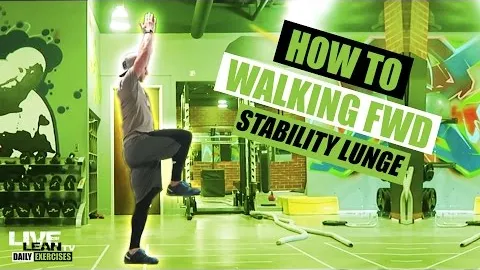
Walking forward stability lunge exercises are an effective way to improve balance, strengthen muscles, and enhance overall stability. This exercise targets key muscles in the lower body, such as the glutes, quadriceps, hamstrings, and calves, while also engaging the core for stability.
Start Position: Begin by standing with your feet hip-width apart, while maintaining good posture and engaging your core muscles.
Step Forward: Take a controlled step forward with your right foot, ensuring that your heel hits the ground first. Aim to lengthen your stride, but not excessively, as you want to maintain stability throughout the exercise.
Lunge: As your right foot lands, bend your knees and lower your body towards the floor, creating a 90-degree angle with both knees. Make sure your front knee stays directly above your ankle and your back knee hovers just above the ground.
Push Off: Using your front heel, push off the ground and bring your back foot forward, stepping into the next lunge with your opposite leg. Repeat the same movement pattern, alternating legs with each step.
Continuity: Continue walking forward, performing lunges with each step, maintaining a steady pace and fluid motion throughout the exercise.
Walking forward stability lunges require significant core engagement and muscle coordination. By practicing this exercise regularly, you can improve your balance and stability, making everyday activities easier and reducing the risk of falls or injuries.
Targeting muscles in the lower body, including the glutes, quadriceps, hamstrings, and calves, this exercise is highly effective for building strength. Developing these muscles can enhance overall lower body function, leading to improved athletic performance and increased power for activities such as running, jumping, and sprinting.
Maintaining balance during the walking forward stability lunge exercise requires a strong core. The muscles in the abdominal area and lower back are engaged to keep the body stable and prevent excessive forward or backward leaning. Strengthening the core muscles can improve posture, stability, and overall strength.
Performing the walking forward stability lunge exercise in a continuous manner can elevate your heart rate and provide cardiovascular benefits. This exercise can be done as part of a circuit training routine or incorporated into a cardio workout to improve stamina and endurance.
To maximize the benefits and safety of the walking forward stability lunge exercise, consider the following tips:
Maintain Proper Form: Focus on good body alignment throughout the exercise. Keep your chest lifted, shoulders relaxed, and gaze forward. Avoid leaning too far forward or backward.
Control the Movement: Perform the exercise in a controlled manner, emphasizing the muscles being targeted. Avoid rushing through the lunges; instead, focus on the quality of each movement.
Increase Intensity Gradually: If you find the walking forward stability lunge exercise too challenging at first, you can start with shorter steps or reduce the range of motion. As you build strength and stability, gradually increase the intensity by taking longer strides or increasing the pace.
Avoid Overexertion: Pay attention to your body and avoid overexerting yourself. If you experience pain or discomfort during the exercise, modify the movement or take a break.
Incorporating the walking forward stability lunge exercise into your fitness routine can bring numerous benefits. This exercise enhances balance and stability while also strengthening the lower body muscles and engaging the core. By following proper form and gradually increasing intensity, you can optimize the effectiveness of this exercise and enjoy the numerous benefits it provides for your overall fitness and well-being.
If you're looking for a gym, fitness club or yoga studio, you've come to the right place.
You can find information about gyms in your area. Browse catalog of gyms and find gyms with classes which are you looking for.
On gym page you can find simple information like address, phone or website. You can find list of available classes. You can check availability of personal training or small group classes. On place page you can also see information about open hours.
You can find gyms near you with amenities, courts, studios and equipments.
Use our map to find gym at your city or district.
In Gym Navigator you can find list of exercises with movies for many body parts.
You can browse exercises catalog and find exercises the best of you.
You can also find exercises grouped into workout plans, which you can use to improve you body. Each routine show you exercises one by one and give you possibility to count you progress and count down rest time.